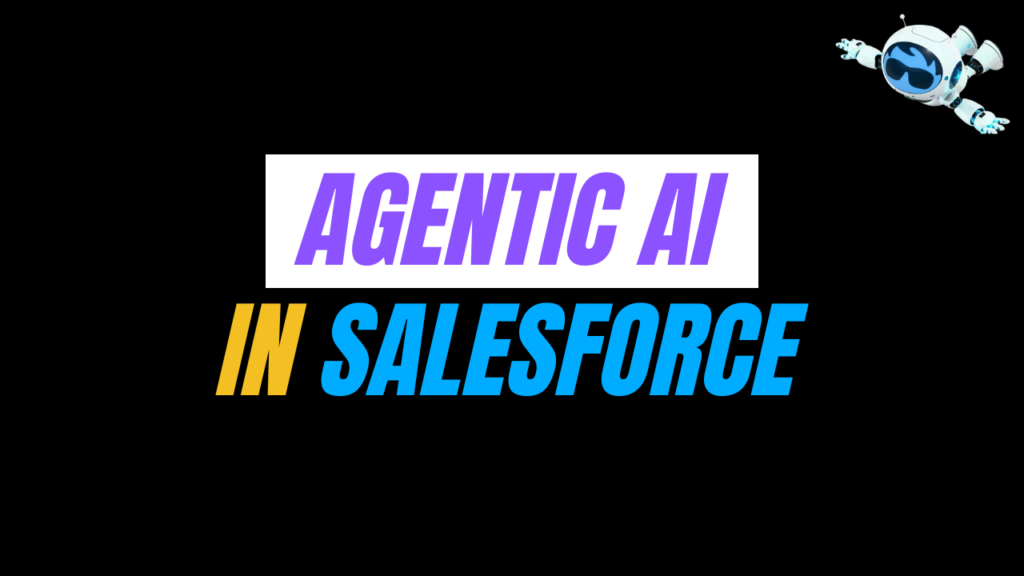What is Agentic AI in Salesforce

In this blog, we’re diving into the world of AI Agents, what Agentic AI means in the Salesforce ecosystem, where it’s being used, the benefits it brings, and how it impacts developers, admins, and businesses.
As AI becomes a bigger part of our everyday tools, we’re seeing a shift from basic AI that just predicts or responds to smarter systems that can actually think, act, and learn on their own.
What is an AI Agent?
AI Agents are the agents that work smoothly without needing human help. It understands the customer request, their goals, and takes action on them and also improves itself over time. While a basic chatbot might only give us specific assistance but AI Agents work individually with minimal human help. However, both are instances of ML and AI; still, they are different applications.
An AI chatbot is designed to mimic human conversation using Natural Language Processing (NLP) and Machine Learning (ML). It’s trained on specific datasets to understand inputs and provide appropriate responses, typically within a defined scope. In other words, chatbots are great for handling repetitive or predictable tasks, but they stick to a script and work within limits.
AI Agents, however, take things to the next level. These are intelligent systems capable of handling complex tasks and making real-time decisions. Built using platforms like AgentBuilder (e.g., Salesforce AgentForce), they leverage advanced machine learning techniques, including deep learning and reinforcement learning, to interpret data from various sources and adjust their behaviour accordingly.
Unlike traditional chatbots that stick to predefined scripts, AI Agents are smarter and more flexible. They understand the context of each interaction, learn from past experiences, and keep improving over time. Whether it’s handling a customer query from start to finish or routing a complex issue to the right human expert, these agents think on their feet. They can adapt to changing situations, tackle multi-step tasks, and make real-time decisions, freeing up human agents to focus on the work that truly needs a human touch
What is Agentic AI in Salesforce?
Agentic AI is all about giving AI agents the ability to operate on their own, with no constant human guidance needed. It acts as a bridge between people and intelligent systems, offering the tools and services these agents need to learn, adapt, and respond effectively. This means they can take on complex tasks with speed and accuracy.
What sets Agentic AI apart from traditional models is its flexibility. Instead of relying on fixed, pre-programmed responses, these agents can think through situations, set their own goals, make decisions, and change their behaviour based on what’s happening around them.
One of the best parts? It simplifies the development and rollout process. Businesses can easily plug these agents into their systems and tailor them to meet specific needs, making AI adoption much more accessible.
Below are the three main characteristics of Agentic AI:
1. Adaptability
2. Goal Orientation
3. Autonomy
Autonomy shows how Agents can make decisions and execute tasks without manual oversight. Adaptability is how agents learn from their previous interaction and understand the context, and also change thier change their decision based on their learning.
How does Agentic AI work?
Agentic AI works through agents, which are a complex network of autonomous software components. These agents are intelligent digital workers which designed with capabilities and objectives to work on complex tasks. They learn from user behaviour, historical records, and real-time inputs — these agents learn, reason, and execute tasks independently or in coordination with one another.
At the heart of Agentic AI is a blend of advanced technologies such as:
- Machine Learning (ML) for pattern recognition and decision-making
- Natural Language Processing (NLP) for understanding and interacting in human language
- Knowledge Representation and Reasoning to process structured and unstructured data
- Large Language Models (LLMs) that help guide complex reasoning tasks
So the overall mechanics of operation of Agentic AI are designed to foster autonomy, adaptability, and efficiency. By using advanced technologies and a collaborative, open-source approach, agentic AI will change various industries and roles, improving the way we interact with technology.
Agentic AI typically follows a five-step operational cycle:
1. Perceive
Agents begin by collecting data from various sources such as sensors, databases, Salesforce records, or user interfaces. They identify meaningful signals and extract the information from them.
2. Reason
By using LLMs and domain-specific models, the agent analyses the situation, identifies the best possible solutions, and then designs a plan. This reasoning process mimics human thought, balancing outcomes, constraints, and available resources.
3. Act
Once AI agents make a decision, they carry it out automatically, whether that means sending a follow-up email, assigning a case, or launching a Flow in Salesforce. These actions happen without manual input. At the same time, built-in safeguards ensure everything stays within set rules, limits, and compliance standards.
4. Learn
After acting, agents collect the feedback and outcomes from their actions. They use this information to improve their future decisions, update their knowledge base, and refine their approach. Over time, this continuous loop results in increasingly smarter behaviour and better performance.
5. Collaborate
Agentic AI systems include agent builder tools that enable developers and business users to build, test, and deploy agents easily. With open-source or low-code/no-code platforms, organisations can customise AI agents for different functions. Moreover, agents can collaborate among themselves, sharing data and coordinating workflows to resolve more complex problems together.
FAQs
Q1. What is the difference between agentic and non-agentic AI?
Non-agentic AI systems need humans to guide them; they can’t work on their own. They’re built for specific tasks and follow direct instructions. In contrast, agentic AI is more advanced. It can understand situations, make decisions, and take action without waiting for someone to tell it what to do.
Q2. What is an example of Agentic AI in Salesforce?
Q3. How does Agentic AI replace human decision-making?
It uses a combination of machine learning, natural language processing, and algorithms to evaluate data, understand the context, and take appropriate actions. These AI agents are capable of setting goals, analysing multiple variables, and choosing the best paths, which is much like a human would — but at greater speed and scale.
While it doesn’t fully replace human decision-making in ethical situations, Agentic AI can handle routine tasks and repetitive decision-making processes, which frees up humans to focus on more complex or strategic work.
Conclusion
Agentic AI is reshaping the way businesses use technology, especially on platforms like Salesforce. These AI agents take action on their own, learn as they go, and handle everyday tasks like answering customer questions or managing leads. That means less manual work, more efficiency, and more time to focus on the big stuff. With tools like Salesforce Agentforce, it’s easier than ever for companies to build smart AI agents that make daily work smoother and smarter.

